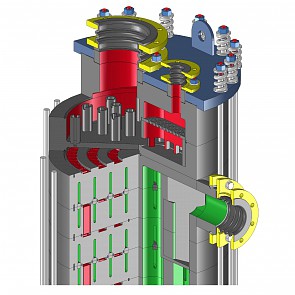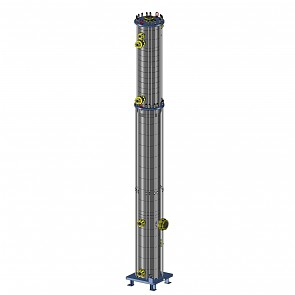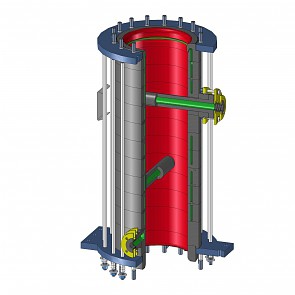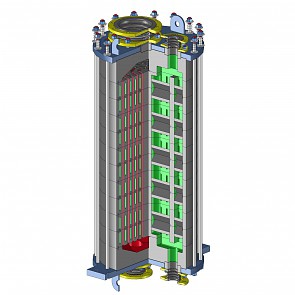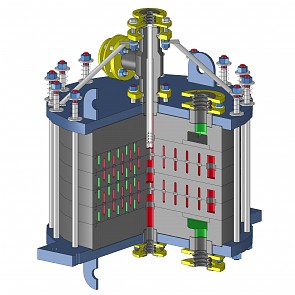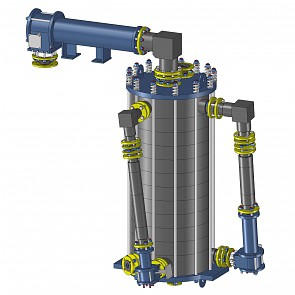Graphite mass transfer equipment
GAB Neumann offers a wide range of graphite mass transfer equipment for the most corrosive applications in the pharmaceutical and the chemical industries. Our product portfolio includes absorbers, columns, quenches, hydrochloric acid recovery units, sulfuric acid dilution units and well as vacuum jet pumps.
Absorbers
Graphite absorbers allow the absorption of ultra-corrosive gases.
Columns & Column internals
Graphite columns can be used for the washing and absorption of ultra-corrosive gases as well as for the distillation or fractioning of ultra-corrosive chemicals.
Quenches
Graphite quenches allow the instantaneous cooling of ultra-corrosive gases.
Processing of hydrochloric acid
GAB Neumann offers a complete range of processes in the field of hydrogen chloride (gaseous HCl) and hydrochloric acid (liquid HCl) treatment. It includes the absorption, cleaning, desorption, rectification, re-concentration (above the azeotropic point) and scrubbing of hydrochloric acid.
Sulfuric acid dilution
Graphite sulfuric acid dilution units allow the smooth and safe dilution of concentrated sulfuric acid and the cooling of the diluted acid.
Steam jet vacuum pumps
Graphite steam jet vacuum pumps allow the generation of vacuum for ultra-corrosive applications.
Materials
- Impervious graphite: GAB GPX1, GPX1T or GPX2
- Shell, Pressure plates and flanges: carbon steel or stainless steel
- Tie rods, nuts, bolts, washers, and springs: stainless steel
- Tanks, containers, and piping: PTFE lined steel or Fiber Reinforced Plastic
Key features
- Design pressure: -1 barg (full vacuum) to +10 barg (145 psig)
- Design temperature: -60 to +200°C (-76 to 392°F)
- Design: according to European Pressure Equipment Directive 2014/68/EU (PED) or ASME Code
Main applications:
- Process guarantees
- Superior process performance
- Outstanding corrosion resistance on one side or on both sides
- Good heat transfer performance thanks to adjustable cross sections on both sides
- Turn-key units and/or skid-mounted units on request
- Custom made design
- High operational safety and reliability
- Short lead time
- Long lifetime
Main applications:
- Absorption, washing or quenching of ultra-corrosive gases
- Recovery of spent acids
- Generation of dry hydrochloric acid
- Dilution of sulfuric acid
- Vacuum generation in ultra-corrosive environment
Mass transfer
Mass transfer is the net movement of mass from one stream, phase, fraction or component, to another. Mass transfer occurs in many processes, such as absorption, evaporation, drying, precipitation, membrane filtration, and distillation. In industrial processes, mass transfer operations include separation of chemical components in distillation columns, absorbers such as scrubbers or stripping, adsorbers such as activated carbon beds, and liquid-liquid extraction.
Mass transfer finds extensive application in chemical engineering problems. It is used in reaction engineering, separations engineering, heat transfer engineering, and many other sub-disciplines of chemical engineering.
The driving force for mass transfer is typically a difference in chemical potential. A chemical species moves from areas of high chemical potential to areas of low chemical potential. Thus, the maximum theoretical extent of a given mass transfer is typically determined by the point at which the chemical potential is uniform. For single phase-systems, this usually translates to uniform concentration throughout the phase, while for multiphase systems chemical species will often prefer one phase over the others and reach a uniform chemical potential only when most of the chemical species has been absorbed into the preferred phase, as in liquid-liquid extraction.
While thermodynamic equilibrium determines the theoretical extent of a given mass transfer operation, the actual rate of mass transfer will depend on additional factors including the flow patterns within the system and the diffusivities of the species in each phase. This rate can be quantified through the calculation and application of mass transfer coefficients for an overall process.
GAB Neumann’s mass transfer equipment and units
GAB Neumann’s graphite absorbers, columns and quenches are designed to absorb, wash, or quench ultra-corrosive gases. GAB Neumann’s columns can also be designed to distillate ultra-corrosive chemicals. GAB Neumann’s hydrochloric acid recovery units enable the absorption then the desorption of hydrochloric acid to generate highly concentrated hydrochloric acid gas with a low moisture content (dry HCl). Our sulfuric acid dilution units allow the safe and progressive dilution of concentrated sulfuric acid. Finally, our vacuum generation groups allow the generation of deep vacuum in ultra-corrosive environment without using any rotating pieces of equipment.
All our equipment and units are designed to meet specific process requirements and are therefore custom made. Safety, reliability, and performance on the long-term are our primary considerations when we size, design and manufacture our mass transfer equipment and units.
Absorbers
Our graphite annular groove isothermal absorbers are adapted to the absorption of ultra-corrosive gases such as hydrochloric, bromhydric or hydrofluoric acids. They consist in a stack of impervious graphite discs with straight flow channels on process side and annular grooves on service side. Their top sections are equipped with liquid distribution plates and overflow candles to ensure homogenous liquid distribution.
Columns
Our graphite columns are adapted to the washing of ultra-corrosive gases as well as the fractioning or distillation of ultra-corrosive chemicals. They consist in a stack of impervious graphite cylinders filled with packing material or with distillation trays. Graphite column internals are used to distribute or collect gaseous and liquid streams at different levels in the columns.
Quenches
Our graphite quenches are design to instantaneously cool down flue gases and therefore prevent the formation of harmful chemicals. They consist in a short graphite column section with a wetting system that ensures an intimate contact between the hot gas and a large quantity of quenching fluid usually water. The whole piece of equipment is cooled down.
Hydrochloric acid recovery systems
Our hydrochloric acid recovery and dry hydrochloric acid generation systems consist in several interconnected pieces of equipment that ensures the absorption of hydrochloric acid, its desorb and its reflux condensation at various temperature to produce dry hydrochloric gas (
Sulfuric acid dilution units
The dilution of sulfuric acid is uneasy (due to the high viscosity of concentrated sulfuric acid) and extremely exothermic. Our sulfuric acid dilution units ensure the safe, smooth, and efficient dilution of sulfuric acid with water as well as the cooling of the diluted acid.
Vacuum groups
Steam jet ejectors offer a simple, reliable, low-cost way to produce vacuum. For low suction pressures, jet vacuum pumps shall be combined in series. Between two jet pumps the motive steam is condensed in order to reduce the energy requirement of the next stage. Our multistage vacuum generation groups consist in combined graphite steam ejectors and condensers. Our multi-stage steam jet vacuum pumps can be designed for suction pressures down to 1 mbar or lower.
Our mass transfer pieces of equipment are modular and can fit with individual process specification. Their size can be adapted best meet the velocities, pressure drops, process and heat transfer requirements.
All our graphite mass transfer pieces of equipment are machined after phenolic resin impregnation thus guarantying a totally free of resin heat transfer surface and ensuring therefore the highest possible heat transfer rate.
Industrial processes:
- Crop protection
- Fumed silica
- Silicones
- Titanium dioxide
- Fine chemicals
- Active pharmaceutical ingredients
- Epichlorohydrin
- Vinyl chloride monomer
- Fire retardants
- Flavors and fragrances
- Vitamins
- Isocyanates
- Viscose
- Polycarbonate
- Coagulants
- Treatment, purification and concentration of spent acids
- Sulfuric acid dilution
- Vacuum generation
- and many more…
GAB Neumann GmbH
Alemannenstrasse 29
79689 Maulburg
Germany
GAB Neumann GmbH | Alemannenstrasse 29 | D-79689 Maulburg | Phone +49 (7622) 6751 0 | Fax +49 (7622) 6751 20 | E-Mail info@gab-neumann.de | www.gab-neumann.com


